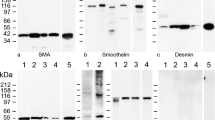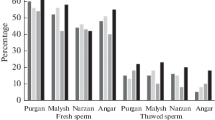Summary
Normal and feminized human testes were examined by means of freeze-fracture. In both cases, the junctional complexes between adjacent Sertoli cells show a unique characteristic feature. Many parallel linear occluding junctions are located circumferentially around the cell surface at the level of the nucleus. They are more than forty in number over one Sertoli cell surface. In the A face, the particles are not prominent on the ridge of the junctions. Instead, they are clearly seen in the center of the groove of the junctions on the B face. Gap junctions consisting of particle aggregation are not found between the Sertoli cells.
The gap junctions between the Leydig cells are frequently observed in both normal and feminized testes. They are round or elliptic in contour and about several micrometers in diameter. The particles, about 8 nm in diameter, are closely packed to form a quasi-hexagonal pattern. The pits are found on the B face corresponding to the particle aggregation.
Similar content being viewed by others
References
Albertini, D.F., Anderson, E.: The appearance and structure of intercellular connections during the ontogeny of the rabbit ovarian follicles with particular reference to gap junctions. J. Cell Biol. 63, 234–250 (1974)
Albertini, D.F., Anderson, E.: Structural modifications of lutein cell gap junctions during pregnancy in the rat and the mouse. Anat. Rec. 181, 171–194 (1975)
Bawa, S.R.: Fine structure of the Sertoli cell in the human testis. J. Ultrastruct. Res. 9, 459–474 (1963)
Belt, W.D., Cavazos, L.F.: Fine structure of the interstitial cells of Leydig in the boar. Anat. Rec. 158, 333–350 (1967)
Brökelmann, J.: Fine structure of germ cells and Sertoli cells during the cycle of the seminiferous epithelium in the rat. Z. Zellforsch. 59, 820–850 (1963)
Chalcroft, J.P., Bullivant, S.: An interpretation of liver cell membrane and junction structure based on observation of freeze-fracture replicas of both sides of the fracture. J. Cell Biol. 47, 49–60 (1970)
Christensen, A.K.: The fine structure of testicular interstitial cells in guinea pigs. J. Cell Biol. 26, 911–935 (1965)
Christensen, A.K.: Leydig cells. In: Handbook of physiol., Endocrinol. 5, p. 57–94. Baltimore: Williams and Wilkins 1975
Christensen, A.K., Gillim, S.W.: The correlation of fine structure and function in steroid-secreting cells, with emphasis on those of the gonads. In: The gonads (McKerns, K.W., ed.), p. 415–488. Amsterdam: North Holland Publ. Co. 1969
Claude, P., Goodenough, D.A.: Fracture faces of zonulae occludentes from “tight” and “leaky” epithelia. J. Cell Biol. 58, 390–400 (1973)
Dym, M.: The fine structure of the monkey (Macaca) Sertoli cell and its role in maintaining the blood-testis barrier. Anat. Rec. 175, 639–656 (1973)
Dym, M.: The fine structure of monkey Sertoli cells in the transitional zone at the junction of the seminiferous tubules with the tubuli recti. Amer. J. Anat. 140, 1–26 (1974)
Dym, M., Fawcett, D.W.: The blood-testis barrier in the rat and the physiological compartmentation of the seminiferous epithelium. Biol. Reprod. 3, 308–326 (1970)
Fawcett, D.W.: Observations on the organization of the interstitial tissue of the testis and on the occluding cell junctions in the seminiferous epithelium. In: Advances in biosciences, 10: The masculine gender (Raspé, G., Bernhard, S., eds.), p. 83–99. Oxford: Pergamon Press 1973
Fawcett, D.W.: Ultrastructure and function of the Sertoli cell. In: Handbook of physiol., Endocrinol. 5, p. 21–55. Baltimore: Williams and Wilkins 1975
Fawcett, D.W., Aoki, A., Gilula, N.B.: Ultrastructure and experimental studies on the seminiferous epithelium (abstract). Proc. 13th Gunma Symp. Endocrinol. I-4, Maebashi 1975
Fawcett, D.W., Leak, L.V., Heidger, P.M.: Electron microscopic observations on the structural components of the blood-testis barrier. J. Repord. Fertil. (Suppl.) 10, 105–122 (1970)
Ferenczy, A., Richart, R.M.: The fine structure of the gonads in the complete form of testicular feminization syndrome. Amer. J. Obstet. Gynec. 113, 399–409 (1972)
Flickinger, C.: The postnatal development of the Sertoli cells of the mouse. Z. Zellforsch. 78, 92–113 (1967)
Flickinger, C., Fawcett, D.W.: The junctional specializations of Sertoli cells in the seminiferous epithelium. Anat. Rec. 158, 207–222 (1967)
Friend, D.S., Gilula, N.B.: Variations in tight and gap junctions in mammalian tissues. J. Cell Biol. 53, 758–776 (1972)
Fujita, H.: Freeze-etching images of the rabbit thyroid gland (abstract). Proc. 10th Int. Congress Anat. p. 270. Tokyo: Sci. Council Japan 1975
Gilula, N.B.: Development of cell junctions. Amer. Zool. 13, 1109–1117 (1973)
Gilula, N.B., Branton, D., Satir, P.: The septate junction: A structural basis for intercellular coupling. Proc. nat. Acad. Sci. (Wash.) 67, 213–220 (1970)
Gilula, N.B., Fawcett, D.W., Aoki, A.: The Sertoli cell occluding junctions and gap junctions in mature and developing mammalian testis. Develop. Biol. (in preparation)
Gilula, N.B., Reeves, O.R., Steinbach, A.: Metabolic coupling, ionic coupling and cell contacts. Nature (Lond.) 235, 262–265 (1972)
Gilula, N.B., Satir, P.: Septate and gap junctions in molluscan gill epithelium. J. Cell Biol. 51, 869–872 (1971)
Ichihara, I.: The fine structure of testicular interstitial cells in mice during postnatal development. Z. Zellforsch. 108, 475–486 (1970)
McNutt, N.S., Weinstein, R.S.: The ultrastructure of the nexus. A correlated thin section and freeze-cleave study. J. Cell Biol. 47, 666–688 (1970)
Nagano, T.: Some observations on the fine structure of the Sertoli cell in the human testis. Z. Zellforsch. 73, 89–106 (1966)
Nagano, T., Suzuki, F.: Freeze-fracture observations on the junctional complexes between the Sertoli cells, with particular reference to their postnatal development (abstract). Proc. 10th Int. Congress Anat. p. 496, Tokyo: Sci. Council Japan 1975
Neaves, W.B.: Permeability of Sertoli cell tight junctions to lanthanum after ligation of ductus deferens and ductuli efferentes. J. Cell Biol. 59, 559–572 (1973)
Nicander, L.: An electron microscopical study of cell contacts in the seminiferous tubules of some mammals. Z. Zellforsch. 83, 375–397 (1967)
Peracchia, C.: Low resistance junctions in crayfish. II. Structural details and further evidence for intercellular channels by freeze-fracture and negative staining. J. Cell Biol. 57, 66–76 (1973)
Schulze, C.: On the morphology of the human Sertoli cell. Cell Tiss. Res. 153, 339–355 (1974)
Staehelin, L.A.: Three types of gap junctions interconnecting intestinal epithelial cells visualized by freeze-etching. Proc. nat. Acad. Sci. (Wash.) 69, 1318–1321 (1972)
Staehelin, L.A.: Further observations on the fine structure of freeze-cleaved tight junctions. J. Cell Sci. 13, 763–786 (1973)
Staehelin, L.A.: Structure and function of intercellular junctions. Int. Rev. Cytol. 39, 191–283 (1974)
Staehelin, L.A., Mulherjee, T.M., Williams, A.W.: Freeze-etch appearance of the tight junction in the epithelium of small and large intestine of mice. Protoplasma 67, 165–184 (1969)
Vitale, R., Fawcett, D.W., Dym, M.: The normal development of the blood-testis barrier and the effects of clomiphene and estrogen treatment. Anat. Rec. 176, 333–344 (1973)
Wade, J.B., Karnovsky, M.J.: The structure of the zonula occludens. A single fibril model based on freeze-fracture. J. Cell Biol. 60, 168–180 (1974a)
Wade, J.B., Karnovsky, M.J.: Fracture faces of osmotically disrupted zonulae occludentes. J. Cell Biol. 62, 344–350 (1974b)
Yamada, E.: Some observations on the fine structure of the interstitial cell in the human testis as revealed by electron microscopy. Gunma Symp. Endocrinol. 2, 1–17 (1965)
Author information
Authors and Affiliations
Additional information
We thank Professor Jean C. Dan for assistance in the preparation of the manuscript. We also thank Drs. Takashi Katayama and Mitsunori Seki for supplying the human tissues. All patients and their families agreed to the scientific presentation of the materials used in this study. This work is supported by grants of the Japanese Ministry of Education.
Rights and permissions
About this article
Cite this article
Nagano, T., Suzuki, F. Freeze-fracture observations on the intercellular junctions of Sertoli cells and of Leydig cells in the human testis. Cell Tissue Res. 166, 37–48 (1976). https://doi.org/10.1007/BF00215123
Received:
Issue Date:
DOI: https://doi.org/10.1007/BF00215123




